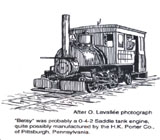T.B.H. Cochrane and the “Betsy” Logging Line
At first the logs were brought down from Grand Valley by teamsters, but in 1887 a narrow gauge railway and tramline were built and a small wood burning steam locomotive (0-4-2 Saddle tank) was acquired and named “Betsy.”5 The logs were hauled by small horse-drawn cars to the turnaround where they were loaded onto cars and hauled by the locomotive to the mill.6 The “impermanent” nature of the track led to constant derailments and injuries and the rather severe grade down Horse Creek into Mitford led to instances of a “run-away” train.7
In 1887 the Cochrane’s house was finished, and the town received its name after a friend of Adela’s, Mrs. Percy Mitford.8 The following year a hotel, store and livery stable and additional bunkhouses were built and a Dr. Hayden opened an office and drug store.9 In 1889 a post office was established and some private homes built, with a saloon being added in 1890 and the Anglican Church in 1892.10
To facilitate crossing the Bow River, Tom Cochrane built a two-span wooden bridge about 100 yards down from the railway bridge. For a while a toll was levied; five cents for a pedestrian and ten cents for horse and cart.11 It was in 1888 that the Cochranes were visited by their friends Algernon and Mrs. St. Maur. Tom and Algernon acquired a two-thirds interest in an underground mine owned by J.W. Vaughn. A spur was built to the mine. Unfortunately, the mine proved uneconomical, the coal being of poor quality and hard to extract. It, along with the sawmill, which also had not been a commercial success, were closed down in 1890.12
An attempt to establish a viable brick making plant with three primitive kilns and drying sheds, and clay brought down from pits north of Mitford, met with failure in 1893 after two summers of operation.13 “Betsy” was sold to a lumber company at Golden, B.C., and the tracks torn up.14 After another abortive coal mine venture at Canmore,15 Tom Cochrane made an unsuccessful bid for a seat in Parliament in 1896, being defeated by Edmonton publisher Frank Oliver. The Cochranes returned to England.16 By 1898 Mitford had ceased to exist, the final indignity being the destruction, by fire, of the Cochranes’s abandoned house in 1905.17
Notes | Bibliography | Abbreviations
1. D.E. Brown, A History of the Cochrane Area (Thesis, University of Alberta, Dept. of History, 1951), p. 37.2. Ibid., p. 38.
3. Ibid.
4. A. St. Maur, Impressions of a Tenderfoot (London: John Murray, 1890), p. 37.
5. D.E. Brown, A History of the Cochrane Area, pp. 38–39.Mr. Brown’s description of the locomotive is inaccurate. Letter, Mrs. Spicer, 25 October 1991; M. Green Richmond, B.C., 16 July 1991.
6. D.E. Brown, A History of the Cochrane Area, p. 40.
7. A. St. Maur, Impressions of a Tenderfoot, pp. 38, 51. Note: Mr. Brown (Letter, 15 October 1991) mentions that horses sometimes had to be used to assist “Betsy” on the steep grade from the valley. Frank White, Treasurer for the Cochrane Ranch Co. in his Diaries, deposited in the Glenbow Archives (M1302) states: “Saw Cochrane and Wilking there (i.e. Mitford) planning to get the stationary engine over the river to assist Betsy up the grade.”
8. D.E. Brown, A History of the Cochrane Area, p. 40.
9. Ibid., pp. 42–43.
10. Ibid., pp. 53, 55.
11. Ibid., p. 55.
12. Ibid., pp. 42, 53. Note: 11 February 1890, F. White wrote: “Hayden tells me they have abandoned the idea of running the saw mill next summer and have virtually abandoned the Coal Creek mine.”
13. D.E. Brown, A History of the Cochrane Area, p. 54.
14. Ibid., p. 56; M. Green, Richmond, B.C.
15. D.E. Brown, A History of the Cochrane Area, p. 55.
16. Ibid., p. 57.
17. Ibid.

